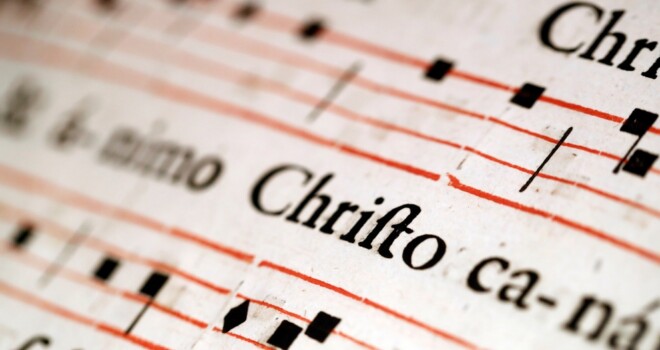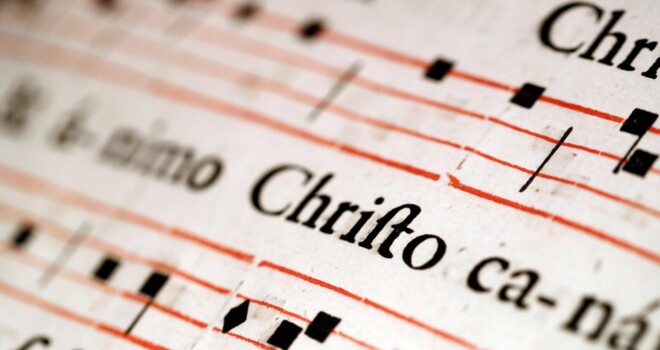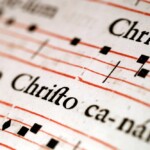A growing number of parishes in the United States are observing the antiphons (or “Propers”) during Mass. During the last sixty years, most parishes sing a variety of hymns during the Entrance, Offertory, and Communion portions of the liturgy. Many Catholics might be surprised to discover that the Church has assigned specific antiphons to be sung at each of these occasions within the Mass. But what are these antiphons, and what has caused their recent growth in popularity?
Antiphons are brief phrases of scripture that are recited or sung with a complimentary set of psalm verses. Far from being a new invention, the antiphons have always been a part of the liturgy, going back to the most ancient times of the Church. Most recently, the Second Vatican Council has reaffirmed the significance of the antiphons and their proper place within the Mass.
Steeped in Scripture
Every time you attend a Catholic Mass, you are exposed to over 120 scripture references. Everything the priest, deacon, and people say (or sing) is deeply rooted in scripture (For example, the Gloria alone contains eleven scriptural references). At the time of the Second Vatican Council, there was a complete revision of the Lectionary for Mass. The Church opened a generous portion of Sacred Scripture to be utilized within a three-year cycle of readings. Many people only associate this treasury of Scripture to be observed during the Liturgy of the Word: First Reading, Response Psalm, Second Reading, and Gospel Reading. In fact, both the Lectionary and Roman Missal are steeped in Scripture. The Missal contains a rich treasury of biblical texts observed by – among other instances – the antiphons. These short expressions of texts are the authentic voice of the Church in the liturgy: the antiphons are the voice of God speaking to His people.
The primary option
The Church instructs the faithful to observe the antiphons as the primary option for liturgical singing. Just as there are assigned readings and psalmody for each day of the week, the missal also designates the Entrance, Offertory, and Communion antiphons. These antiphons are specifically assigned by the Church to help reveal the particular mystery being celebrated on any given day.
Recently, the bishops of the United States have rearticulated the significance of the antiphons within the Mass. Collectively, the bishops stated in 2007:
“The singing of an antiphon and psalm during the entrance procession has been a longstanding tradition in the Roman Liturgy. Antiphons and psalms may be drawn from the official liturgical books—the Graduale Romanum, or the Graduale Simplex—or from other collections of antiphons and psalms.” (Sing to the Lord: Music in Divine Worship, 144)
In more recent years, bishops have been issuing pastoral letters to emphasize the significance of singing the antiphons during worship. In 2019, Archbishop Alexander Sample of Portland wrote to his diocesan musicians:
“Using the texts and musical settings for [the antiphons] is the first and preferred option. It is worth noting that many of the texts for these chants as they are found in the Roman Missal are relatively new, and new musical settings for them, in Latin and English, are even now being composed by church musicians.” (Sing to the Lord a New Song)
Just this past September, Bishop Carl Kemme from the Diocese of Wichita prepared a letter for his own flock. He reemphasized the importance of observing the antiphons at Mass:
“I have asked that we model the preference for singing the antiphons given to us by the Church, also incorporating some elements of Latin as the Second Vatican Council suggested, and singing by the priest celebrant at the times asked for by the Church.”
An abundance of resources
The rise in antiphon popularity also stems from the economic advantages provided for parish musicians. Most of the antiphon settings are available online for free – with no copyright claiming necessary. Websites such as ccwatershed.org not only provide a plethora of free resources but also provide audio practice files for parish musicians. There are also many antiphon texts that have been set to common hymn tunes that most Sunday adorers can already sing quite easily (also available for free). Websites like antiphonrenewal.com provide antiphons set to hymn tunes for keyboard, choir, and assembly – available in English, Spanish, and Latin. Missal companies like Source & Summit are leading the charge to reinvigorate the rich beauty of chanting antiphons, ordinary Mass settings, and more.
The antiphons are the best-kept secret within the Roman Missal. The Church has been begging parish musicians to utilize them for centuries. To unveil even more Sacred Scripture within the liturgy can only invite even more grace from God. To utilize the antiphons within the liturgy is to unleash the awesome beauty of the Word of God within the context of the most perfect Sacrifice of the Mass. May we all partake of His holiness. (Hebrews 12:10)
image: Antiphonary in France by godongphoto / Shutterstock












